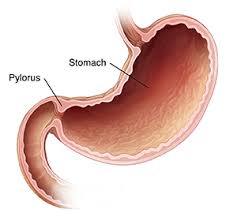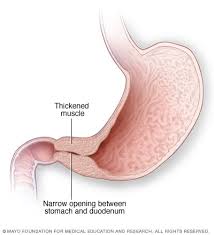The pyloric canal ends as the pyloric orifice, which marks the junction between the stomach and the duodenum. 

‘The pylorus connects the stomach to the duodenum.
The pylorus is considered as having two parts, the pyloric antrum, which open to the body of the stomach and the pyloric canal opening to the duodenum.
The pyloric canal ends as the pyloric orifice, which marks the junction between the stomach and the duodenum.
The orifice is surrounded by a sphincter, a band of muscle, called the pyloric sphincter.
The pylorus is the furthest part of the stomach that connects to the duodenum.
The pyloric antrum is the initial portion of the pylorus, near the bottom of the stomach, proximal to the pyloric sphincter, which separates the stomach and the duodenum.
Peristaltic contraction of the prepyloric sphincter may temporarily or partially or completely it shut off from the remainder of the stomach.
The canal canalis pyloricus) is the opening between the stomach and the duodenum.
The wall thickness of the pyloric canal is up to 3 millimeters infants younger than 30 days.
The wall thickness of the pyloric canal is
up to 8 mm in adults.
The pyloric sphincter/valve, is a ring of smooth muscle at the end of the pyloric canal which lets food pass from the stomach to the duodenum.
The pyloric sphincter controls the outflow of gastric contents into the duodenum.
The pyloric sphincter has sympathetic innervation from the celiac ganglion.
Microscopic cross-section of the pylorus
demonstrated numerous glands, including gastric pits, which constitute about half the depth of the pyloric mucosa.
Gastric pits consist of two or three short closed tubes opening into a common duct or mouth.
The duct is lined by columnar cells, continuous with the epithelium lining the surface of the mucous membrane of the stomach, the tubes by shorter and more cubical cell which are finely granular.
The glands contain mucus cells and G cells that secrete gastrin.
The pylorus also contains scattered parietal cells and neuroendocrine cells.
These endocrine cells include D cells, which release somatostatin, responsible for shutting off acid secretion.
Unstriated involuntary muscles are located at the pylorus.
Food from the stomach, as chyme, passes through the pylorus to the duodenum, and the pylorus, through the pyloric sphincter, regulates entry of food from the stomach into the duodenum.
With stomach cancer, tumors may partly block the pyloric canal.
Pyloric stenosis refers to a pylorus that is narrow due to congenital hypertrophy of the pyloric sphincter.
This problem is often detected in the early weeks of life, when a newborn baby may projectile vomit after eating, but despite vomiting remain hungry.
Pyloric stenosis may be managed by the insertion of a stent, or through surgical cutting of the pyloric sphincter, a pyloromyotomy.
